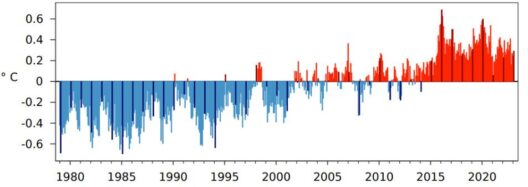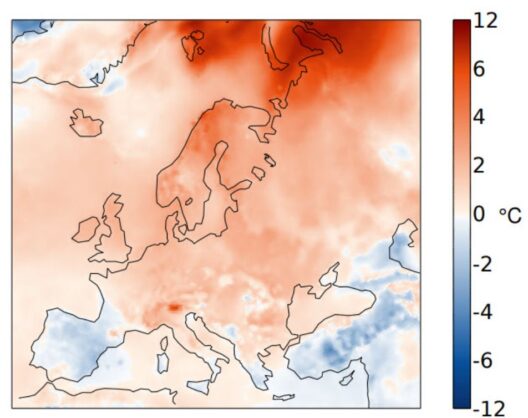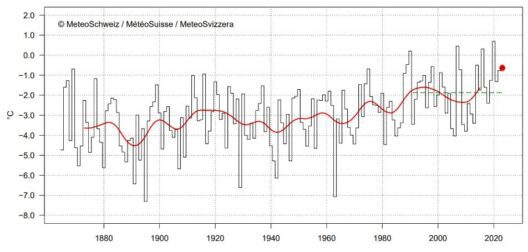It was the fifth-warmest February worldwide and the second-warmest February in Europe in the Copernican data set from 1979.
Most parts of Europe saw above-average readings for February, with temperatures well above average in Eastern Europe and parts of northeastern Europe.
Very moderate in the global average
On a global average, the average February 2023 temperature was 0.29°C warmer than the 1991-2020 average. It was the fifth warmest February in the Copernicus data set since 1979. Compared to February 2016, the month with the largest positive deviation in the entire data set, February 2023 was 0.4°C cooler.

Figure 2: Monthly global temperature from January 1979 to February 2022, plotted as a deviation from the 1991–2020 mean. Black bars indicate the months of February. Source: Copernicus.
Global overview
February 2023 brought above-average temperatures across much of northwestern Eurasia, as well as into Pakistan and India. India had its warmest February since measurements began in 1901. It was also a mild February in central and northwestern Africa and southern South America.
In contrast, the regions with below-average values for February were northern Canada, northeastern Russia, northern South America, northeastern and southern Africa.
There were clear differences in regional temperatures in the United States and Australia. The United States recorded above-average values in the eastern regions and below-average values in the western regions. In Australia, the western regions were warmer than average, while the northern regions saw below average temperatures.
Air temperature over the oceans
February temperatures were above average over the northeastern North Atlantic, most of the North Pacific, the southwestern part of the South Atlantic and the western part of the South Pacific. February was cooler than average in the central tropics, the northeastern Pacific Ocean, and in an area off the coast of West Antarctica. La Niña conditions continued to weaken. February temperatures were also below average across much of the Indian Ocean, off eastern Australia and in the Labrador Sea.
Moderate in Europe too
The temperature in February was above the 1991-2020 average for most European regions. Above-average values are found in northern Norway and Sweden, and northwestern Russia in areas around the Kara Sea and in the Svalbard region.
The United Kingdom recorded the fifth mildest February since records began in 1884. In contrast, February temperatures in the Iberian Peninsula, Turkey, parts of the Caucasus, and northern Italy were below the 1991-2020 average.
The European average for February was 1.2°C above the 1991-2020 average. However, it is not one of the 10 mildest February months in the Copernicus dataset from 1979. Compared to the record for February 1990, February 2023 was 2.75 °C colder.

Figure 2: The spatial distribution of February temperatures in Europe in 2023 with a deviation from the 1991-2020 average in degrees Celsius. A strong positive anomaly around northern Italy, particularly Trentino, may not be realistic. At best, the model used has problems explaining the lack of snow in the area. Source: Copernicus.
Northern Hemisphere winter
The average seasonal temperature in the United States parallels the average February temperatures, with mild conditions in the east and cool conditions in the west. Much of eastern Canada, Alaska, northern Africa, the Middle East, central Asia, southern South America, and parts of Antarctica also had milder-than-average weather throughout the season. In contrast, northern South America, northeastern Russia, and northern and eastern Australia were cooler than average.
In Europe, the 2022/23 winter temperature was well above the 1991-2020 average. In Eastern Europe and northern Scandinavia it was well above average. Winter values remained below average in parts of Norway, Sweden and western Russia, as well as in Iceland and the southern half of Greenland.
The average European winter temperature rose 1.4°C above the 1991-2020 average. Along with the winter of 2015/2016, it was the second-warmest European winter in the Copernicus data set since 1979. The warmest winter of 2019/20 was almost 3°C warmer than the 1991-2020 average.

Figure 4: The spatial distribution of global temperature from December 2022 to February 2023 (Northern Hemisphere winter) as a deviation from the 1991–2020 mean temperature. Source: Copernicus.
the Copernicus connection For February 2023 and Winter 2022/23 available in English.
February and winter in Switzerland
February was spring-like, with very sunny in some areas and very little precipitation until the last third of the month. In some areas, this month was one of the mildest, sunniest and driest February since the measurements began. And in the mountains, this was the locally snowiest month since measurements began.
Switzerland has had one of its mildest winters since measurements began in 1864. It started cold with snow and reached lower elevations in the first half of December. But then a very long and very light period followed until mid-January. The beginning of the year was exceptionally mild with record temperatures. There was a constant lack of snow in the Alps. There was no noticeable cooling until the second half of January. On the other hand, February was again very spring-like, very sunny in some areas and very little rain.

Figure 5 Winter temperature (December to February) in Switzerland since measurements began in 1864. The red dot shows the current winter (-0.6°C). The broken green line shows the 1991-2020 norm (-1.9°C), and the red line shows the 20-year moving average. (MeteoSwiss)
In the section there is a comprehensive overview for February 2023 and winter 2022/23 in Switzerland Publications to exist.
Cover image: Figure 1: Spatial distribution of global temperature in February 2023 as deviation from the 1991–2020 mean in °C.
Source: Swiss Federal Office of Meteorology and Meteorology / February and Winter 2023 at the global level – MeteoSwiss (admin.ch)
Cover image: Copernicus

“Award-winning music trailblazer. Gamer. Lifelong alcohol enthusiast. Thinker. Passionate analyst.”







More Stories
Soldier of the Year: Prince Harry honors US soldier Elizabeth Marks
Moderators don't recognize Liz Truss
Wimbledon 2025 goal – Boris Becker is no longer insolvent – Culture and Entertainment